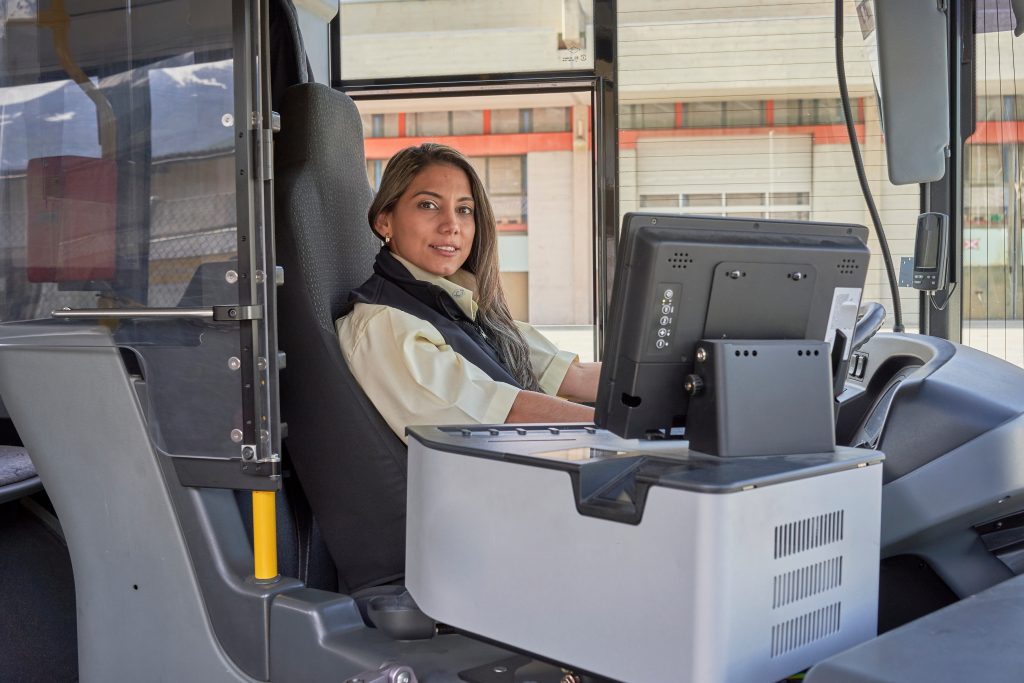Contents
 Bus drivers are in high demand. Hiring bonuses and salary hikes for passenger vehicle drivers have risen due to shortages following the COVID-19 recession. Cities and schools need bus drivers. In fact, the demand for this occupation has resulted in a 25% employment growth over the next ten years. If you’re considering this career path, now is an ideal time to get informed on how to become a bus driver.
Bus drivers are in high demand. Hiring bonuses and salary hikes for passenger vehicle drivers have risen due to shortages following the COVID-19 recession. Cities and schools need bus drivers. In fact, the demand for this occupation has resulted in a 25% employment growth over the next ten years. If you’re considering this career path, now is an ideal time to get informed on how to become a bus driver.
How Do You Become a Bus Driver?
Entry requirements vary for the different types of passenger vehicle drivers. Some drivers are expected to meet different standards depending on which passenger vehicle they drive. However, most bus drivers, for example, must meet education, training, and licensing requirements. Education for bus driver positions consists of a high school diploma or equivalent. While there is no formal education for bus driver jobs, training is required. Training, in lieu of a bus driver degree, takes approximately one to three months. Bus drivers typically undergo on-the-job training and learn as they work alongside a more experienced driver. Part of the initial training period consists of practicing various driving maneuvers in a bus and on a driving course. After completing the initial training, bus drivers begin driving in light traffic. Eventually, they make practice runs on the type of route that they will be expected to drive. Once the new driver has completed enough practice runs, they will make scheduled trips with passengers and a more experienced driver-mentor. The mentor will offer tips and suggestions, answer questions, and evaluate the new driver’s performance. Once evaluations are complete, the new driver will operate the bus alone and make regularly scheduled trips.What Degree Does a Bus Driver Need?
There is no degree for bus driver jobs. In fact, bus drivers typically need only a high school diploma or its equivalent. However, training is essential. Aspiring bus drivers must undergo one to three months of training and satisfy evaluation requirements to operate a bus alone on a regularly scheduled route.What Does It Take to Be a Bus Driver?
While there is no bus driver schooling, several other requirements to operate a passenger vehicle are necessary. Education As explained above, there’s no required degree to become a bus driver. You need a high school diploma or its equivalent, but no college degree. However, training is required. And in some cases, licensing, certifications, and registration are required as part of the job. Also, drivers should have clean driving records with no excessive speeding tickets. Licensing Requirements Bus drivers must be licensed with the appropriate licensing. This includes a commercial driver’s license or CDL. Qualifications for a CDL vary by state, but generally require both knowledge and driving tests. Depending on what kind of bus driver, endorsements may be earned. Endorsements reflect the ability of the driver to operate a certain type of vehicle. All bus drivers must have a (P) endorsement for transporting passengers. School bus drivers must have a (P) endorsement as well as an (S) endorsement for operating a school bus. Earning a (P) and (S) endorsement requires additional knowledge. Drivers take an additional test administered by a certified examiner. Training In your efforts to research how to become a bus driver, it’s important to know what training is required. For bus drivers, a short training of one to three months is necessary to go to work. During this time, you’ll drive with a more experienced bus driver. The driver will offer tips, suggestions, and perform an evaluation. Other Important Qualities While you don’t need a bus driver college degree to land a job, there are important qualities a driver should have to operate a passenger vehicle. These qualities include:
Training In your efforts to research how to become a bus driver, it’s important to know what training is required. For bus drivers, a short training of one to three months is necessary to go to work. During this time, you’ll drive with a more experienced bus driver. The driver will offer tips, suggestions, and perform an evaluation. Other Important Qualities While you don’t need a bus driver college degree to land a job, there are important qualities a driver should have to operate a passenger vehicle. These qualities include: - Ability to hear: Hearing ability is important for bus drivers. Federal regulations require bus drivers to have the ability to hear a forced whisper in one ear at five feet, with or without the use of a hearing aid.
- Ability to see: Visual ability is important for bus drivers to meet federal regulations. Vision tests are administered to bus drivers to ensure they have at least 20/40 vision with a 70-degree field of vision in each eye. They should also be able to distinguish colors of a traffic light.
- Customer service skills: Since drivers interact with passengers, a courteous and helpful demeanor is important. Bus drivers should have good customer service skills.
- Dependability and reliability: Since customers rely on bus drivers to show up on time and transport them to their destination, it helps if the driver is reliable, dependable, and timely.
- Good hand-eye coordination: The federal regulations for bus drivers require normal use of arms and legs. Drivers must watch their surroundings to avoid obstacles while operating a bus. They must be able to avoid hazards and react quickly to safely operate the vehicle.
- Patience: From rude passengers to heavy congestion and traffic, some aspects of the job are challenging. Bus drivers must remain calm and composed when under pressure.
- Punctual: Bus drivers must stick to tight schedules to keep their routes running on time. Being punctual also keeps passengers happy. Bus drivers must be able to manage their time well, which includes accounting for heavy traffic, congestion, and other circumstances that may contribute slowing down driving time.
How Long Does It Take to Become a Bus Driver?
Bus driver training typically takes one to three months to complete. To qualify for a bus driver position, applicants must have a high school diploma or its equivalent. But with a high school diploma, plan to spend a short time learning on the job. Some employers offer shorter training periods for candidates who already hold a commercial driver’s license (CDL).How to Become a Bus Driver Without a Degree
Since no degree for bus driver positions is required, eligibility comes from obtaining a high school diploma and adequate training. As stated above, there are three requirements for becoming a bus driver:- High school diploma
- Training
- Certification or licensing

Certifications or Licenses for Becoming a Bus Driver
Since April 1992, commercial driver’s licenses (CDLs) have been required to operate most of the larger vehicles seen on the road. All bus drivers must have a CDL. In some states, new bus drivers may earn their CDL during their training period. While qualifications for the CDL vary by state, most include passing both knowledge and driving tests. If an applicant does not have clean license, or their CDL was suspended in another state, another state can refuse to issue a new CDL. There are several steps to qualifying to get a CDL license. These qualifications include:- Be at least 18 years of age (21 years of age if driving across state lines)
- Provide proof of state residency and US residency
- Submit a Medical Examination Report Form
- Pass a vision test
- Pass a knowledge test
- Upon passing both tests, receive a Commercial Learner’s Permit
- Wait a minimum of two weeks before scheduling the CDL road skills exam
- Pass the road skills and driving examination
How Much Money Does a Bus Driver Make?
According to the Bureau of Labor Statistics (BLS), both transit and intercity bus drivers earn a median annual wage of $45,900. With the average earnings for all occupations as $41,950, according to the BLS, bus drivers earn higher than average wages. However, the highest 10% of earners in this occupation see much higher earnings of $72,750. Certain factors impact earnings for this occupation. These include:- Industry
- Geographic location
- Local government (excluding education and hospitals): $54,670
- Urban transit systems: $42,360
- Interurban and rural bus transportation: $41,760
- Charter bus industry: $36,680
- New York: $64,330 (annual mean wage)
- Alaska: $60,400
- Washington: $59,880
- Massachusetts: $56,930
- California: $54,560
- San Jose-Sunnyvale-Santa Clara, California: $66,380 (annual mean wage)
- Santa Cruz-Watsonville, California: $63,390
- New York-Newark-Jersey City, New York, New Jersey, Pennsylvania: $63,300
- Seattle-Tacoma-Bellevue, Washington: $63,200
- Salinas, California: $61,900
- Alaska nonmetro area: $59,720 (annual mean wage)
- Southern Ohio nonmetro: $48,450
- Western Washington nonmetro: $48,400
- Northwest Colorado nonmetro: $48,400
- Northwest Oklahoma nonmetro: $43,270

What is the Job Outlook for Bus Drivers?
The job outlook for bus drivers is highly favorable over the next decade. In fact, the Bureau of Labor Statistics (BLS) reports an overall employment hike of 25% through 2030 for this occupation. Since the average employment growth for all occupations is 8%, the employment growth for bus drivers is nearly three times the national average. According to the BLS, approximately 134,800 openings for bus and passenger vehicle drivers are anticipated each year over the next decade. Most of these openings are expected to result from the growing need to replace workers who exit the labor force through retirement or transferring to a different occupation. However, other reasons are also impacting growth. Recovery efforts from the COVID-19 recession that began in 2020 and are expected to continue over the next several years have led to the employment growth for bus drivers. Due to risks of exposure to the virus, many bus drivers have retired early or found work in another occupation. As a result, school district, transit, and intercity bus drivers are in high demand.What is the Work Environment Like for Bus Drivers?
According to the BLS, transit and intercity bus drivers held approximately 165,200 jobs last year. The largest employers of bus drivers include:- Local government, excluding education and hospitals: 48%
- Urban transit systems: 16%
- Charter bus industry: 7%
- Interurban and rural bus transportation: 5%
- Bad weather
- Heavy traffic
- Unruly passengers
Related Resources:
- 30 Great Degree Programs for Working Adults
- 20 Best Affordable Online Bachelor’s in Electrical Engineering
- Top 30 Affordable Online Bachelor’s in Computer Engineering Degrees
- Top 10 Best Majors for Indecisive Students
- Ultimate Guide to Trades Degrees and Careers
